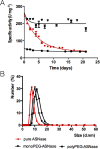Novel site-specific PEGylated L-asparaginase
- PMID: 30753228
- PMCID: PMC6372183
- DOI: 10.1371/journal.pone.0211951
Novel site-specific PEGylated L-asparaginase
Erratum in
-
Correction: Novel site-specific PEGylated L-asparaginase.PLoS One. 2019 Oct 24;14(10):e0224592. doi: 10.1371/journal.pone.0224592. eCollection 2019. PLoS One. 2019. PMID: 31648262 Free PMC article.
Abstract
L-asparaginase (ASNase) from Escherichia coli is currently used in some countries in its PEGylated form (ONCASPAR, pegaspargase) to treat acute lymphoblastic leukemia (ALL). PEGylation refers to the covalent attachment of poly(ethylene) glycol to the protein drug and it not only reduces the immune system activation but also decreases degradation by plasmatic proteases. However, pegaspargase is randomly PEGylated and, consequently, with a high degree of polydispersity in its final formulation. In this work we developed a site-specific N-terminus PEGylation protocol for ASNase. The monoPEG-ASNase was purified by anionic followed by size exclusion chromatography to a final purity of 99%. The highest yield of monoPEG-ASNase of 42% was obtained by the protein reaction with methoxy polyethylene glycol-carboxymethyl N-hydroxysuccinimidyl ester (10kDa) in 100 mM PBS at pH 7.5 and PEG:ASNase ratio of 25:1. The monoPEG-ASNase was found to maintain enzymatic stability for more days than ASNase, also was resistant to the plasma proteases like asparaginyl endopeptidase and cathepsin B. Additionally, monoPEG-ASNase was found to be potent against leukemic cell lines (MOLT-4 and REH) in vitro like polyPEG-ASNase. monoPEG-ASNase demonstrates its potential as a novel option for ALL treatment, being an inventive novelty that maintains the benefits of the current enzyme and solves challenges.
Conflict of interest statement
The authors have declared that no competing interests exist.
Figures






References
-
- Soares AL, Guimaraes GM, Polakiewicz B, Pitombo RNM, Abrahao-Neto J. Effects of polyethylene glycol attachment on physicochemical and biological stability of E. coli L-asparaginase. Int J Pharm. 2002; 237:163–170. - PubMed
-
- Sigma-Tau. Pharmaceuticals. Oncaspar. Highlights of prescribing information U.S. License No. 1850 I-301-21-US-B, 1994.
Publication types
MeSH terms
Substances
LinkOut - more resources
Full Text Sources
Other Literature Sources

